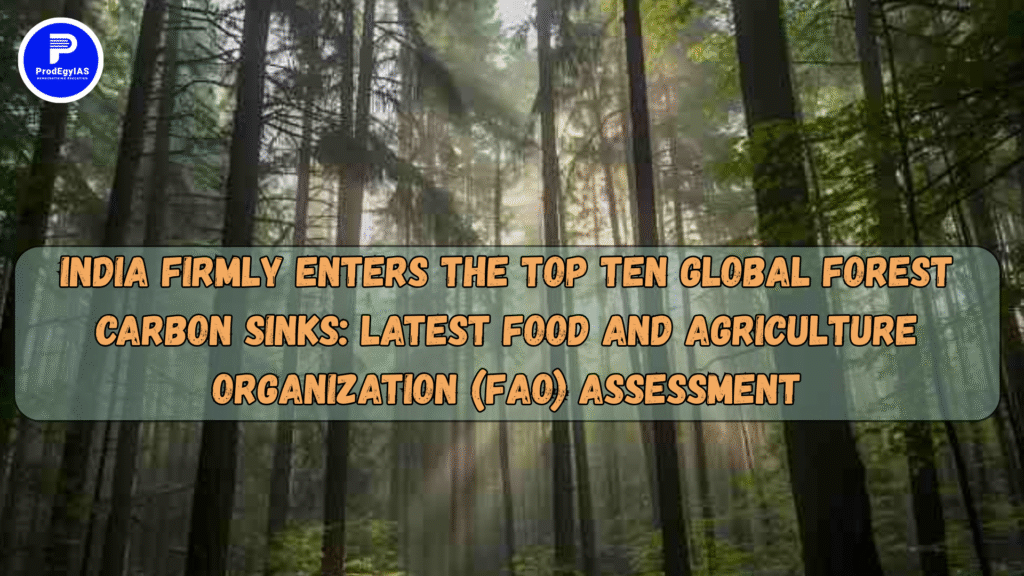
India has achieved a major milestone in its efforts to combat climate change by entering into the the top ten global forest carbon sinks.According to the FAO’s most recent Global Forest Resources Assessment 2025 (GFRA 2025), it ranks in the top ten nations in the world for forest-based carbon sinks.. About 150 million tonnes of CO₂ were absorbed annually by Indian woods between 2021 and 2025, enhancing India’s reputation for climate mitigation and sustainable forestry.
This accomplishment fortifies India’s ecological and policy narratives at a time when the world is searching for practical nature-based solutions to climate change.
Report Highlights
- India now ranks third in terms of net annual forest gain and ninth in terms of total forest area worldwide.
- With 150 Mt CO₂ absorbed annually between 2021 and 2025, India ranks among the top five carbon-sink countries, according to the GFRA 2025.
- In that time frame, woods served as a net carbon sink of almost 0.8 billion tonnes of CO₂ per year worldwide, highlighting the increasing significance of afforestation and forest health. Importance to India’s Climate Policy
There are several strategic ramifications to this development:
- By demonstrating quantifiable increases in carbon sequestration, it supports India’s position as a responsible climate actor.
- It improves the nation’s negotiating position in international fora where nature-based solutions are becoming more popular, such the Paris Agreement and the UN-led climate process.
- It supports the idea of “growth & sustainability” by demonstrating how India’s development path can coexist with environmental responsibility.
Important Difficulties & Challenges
There are still a few warning signs in spite of the encouraging headline numbers:
- The species mix, forest density, biodiversity and ecosystem resilience are important factors that assure the long-term sustainability of carbon sinks because the quantity by itself does not ensure quality.
- Large plantations can occasionally trump local concerns therefore the benefits must reach people that depend on forests and have their rights and means of subsistence maintained.
- The credibility of the sequestration numbers in international accounting depends on strong monitoring, verification and reporting (MRV) procedures.
- Without careful management, pressure from infrastructure growth, urbanisation and climate impacts (such as pests and fires) might reverse improvements.
5. India’s Strategic Measures
- India should prioritise quality restoration by prioritising native species, mixed forests and ecosystem rehabilitation over merely expanding its forest area in order to solidify this accomplishment and turn it into long-term benefits.
- For carbon-sink benefits to be in line with forest-based livelihoods and local empowerment, community-led forestry methods should be strengthened.
- Utilise cutting-edge remote sensing technology (such as LiDAR, satellite analytics and biomass mapping) to improve carbon accounting’s accuracy and transparency.
- To mobilise private capital and innovation, connect carbon-sink initiatives with green finance such as international funds, carbon-credit markets, and REDD+-style systems.
- Integrate the National Mission for a Green India, the National Afforestation Program and larger ecosystem-restoration projects with forest-carbon goals to provide policy coherence.
More than just a statistical accomplishment, India’s rise to the top of the global forest carbon sinks signifies a fundamental change in the way trees affect the climate, economy and society. But turning this milestone into long-term ecological health, social inclusion and open carbon accounting ,it will be the true test. This acknowledgement could serve as the cornerstone of a more resilient and environmentally friendly future if India is able to do it.
UPSC General Studies Paper Preparation
| Topic | |
| UPSC Syllabus | UPSC Free Notes |
| UPSC Optional Subjects | Khushhali Solanki (AIR 61, UPSC CSE 2023) |
Public Administration Optional Exam Preparation
Topic | |
About the Author: Jyoti Verma



